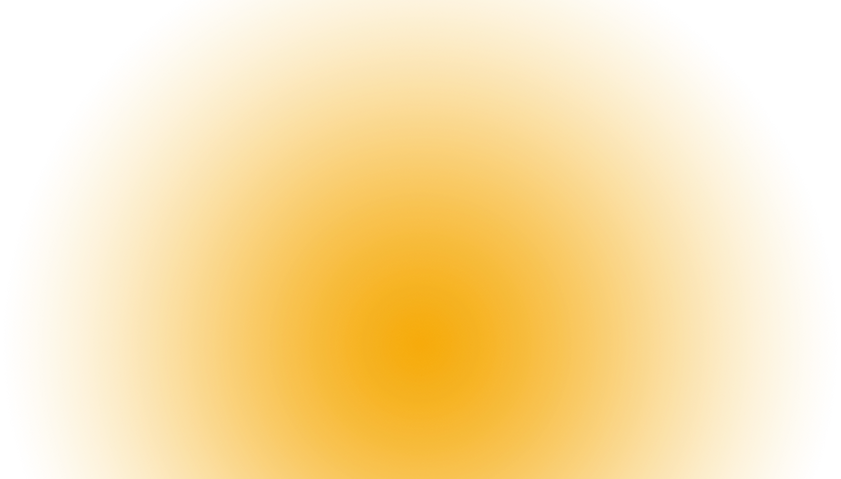
HUGMEDAPP
01
Our introduction.
Medication Management App for Older Adults and Caregivers
A personalized medication management system designed to address prescription non-adherence, targeting older adults managing multiple medications, and their caregivers.
Role
UX Design | UI Design | User Research | Project Management | Product Strategy

Caregiver Portal
For caregivers to monitor the patient’s medication adherence, receive alerts, and intervene if necessary.

IoT Device
A smart sticker attached to each pill bottle that tracks medication intake and provides reminders.

Patient Portal
For patients to manage their medications, receive reminders, and track their adherence.
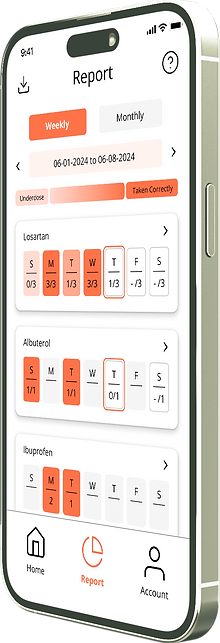

02
OUR market & needs.
65+ Population in the US
9/10
take prescription meds
4/5
take at least 2 meds
1/3
take 5 or more prescription meds
Non-Adherence Rates
25-50%
34%
due to 'forgetfulness'
5-10%
of all medicines prescribed missed or skipped
Responsible for
10%
of all hospitalizations
Bussiness Opportunity
Prescription Market
+
4-5%
Compound Annual Growth Rate
Supplement Market
+
5-6%
Compound Annual Growth Rate
$72
$62
$53
2024
2027
2030
Serviceable Obtainable Market
03
Our user.
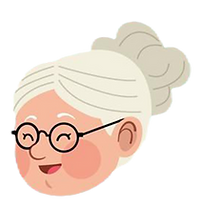
Name: Alice Johnson
Age: 72
Low Tech Proficiency: Uses a smartphone mainly for basic tasks like calls and texts, but finds more complex apps confusing and difficult to navigate.
Living Situation: Lives alone but has regular visits from her children
Alice has been managing hypertension and Type 2 diabetes for over a decade, taking six medications daily with varying schedules. Occasional memory lapses make it hard to track her medications, frustrating her when discussing adherence with doctors. She values her independence but struggles to provide accurate information, complicating treatment adjustments.
Insight
Simplification
How can we enable users with low tech proficiency to navigate the design effortlessly and confidently?
Automation
How can we reduce users’ reliance on caregivers by minimizing manual input and simplifying the process of tracking medication intake?
Visualization
How can we present users with clear and intuitive visualizations of their medication habits to improve communication with doctors? How can we ensure medication records are scannable and easy to understand at a glance?
Pain Points

Forgetfulness
Forgetfulness when it comes to keep track of medication and refills.
Lack of Record
Resulting in a lack of understanding of her medication habits when discussing with doctors.

Dependence
Want to manage her health on her own without relying on caregiver for reminder or communication with the doctor.

Low Tech Proficiency
Making it hard for her to find the information she needs quickly.
04
Our challenge.
Older adults who struggle with medication adherence need a simple and intuitive way to manage multiple medications and track their adherence in order to maintain their independence and effectively communicate their medication habits to their doctors.
05
Our concept.
User Journey
The user journey is designed to make taking and recording medication effortless, providing a step-by-step process that minimizes cognitive burden.
Remind
A smart sticker attached to medication bottles sends reminders to patients. Both a web portal and mobile app deliver reminders to patients.
Record
Patients confirm medication intake by pressing a button on the smart sticker or using the app.
Report
The system generates reports showing medication intake over time, accessible to both patients and caregivers.

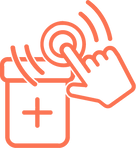

Information Architecture


06
Our Solution.
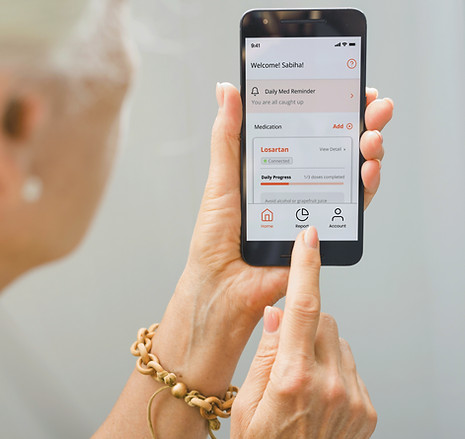
A medication management app designed specifically for older adults who want to stay independent while managing multiple prescriptions. By focusing on simplicity, automation, and visualization, the app removes the frustration of complex tools and manual tracking. It provides timely reminders, an easy-to-follow setup, and automated progress tracking that keeps users on schedule with minimal effort. To support communication with doctors and caregivers, the app also generates scannable reports and a calendar view of medication habits, making adherence patterns clear at a glance. Altogether, the app empowers users to confidently manage their medications, reduce reliance on caregivers, and maintain better health with ease.
Notification
Smart Alerts
Action Guidance
Tailored Reminders
The notification appears on the home page, providing all the necessary information and guiding users on what to do next.
Name of the Medication
Press button to Record
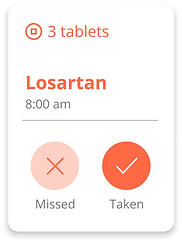
Dosage
Time to Take the Medication
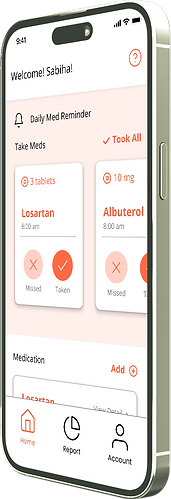

Progress
Motivation
Tracking
Progress Tracking
Notes
A progress bar tracks daily medication intake and previews upcoming doses, giving users a clear sense of their progress throughout the day.
This helps users stay on schedule and reduces the likelihood of missed doses. The progress bar also serves as a motivational tool, visually rewarding users for staying on track with their routine.

Progress Bar
Device Connnection
Guided
Efficiency
Setup
Step-by-Step Setup
The setup process is designed around typical medication routines, prompting users to input dosage, refill dates, and pharmacy details for reminders. It allows users to set up multiple medications at the same time of the day, eliminating the need to input the same information repeatedly.
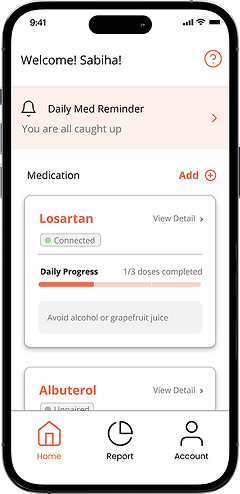
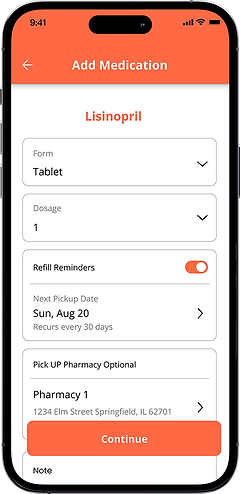




Report
Clarity
Insight
Scannable Reports
The report is designed to be easily scannable, using color-coded visuals to convey the user's medication intake status at a glance. This feature helps users and caregivers quickly understand adherence patterns and identify areas for improvement.
Use of color to indicate adherence status (regular vs. missed doses)
Designed to be suitable for different situations
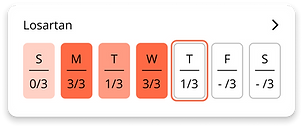
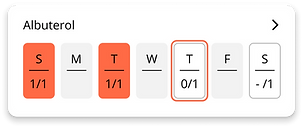
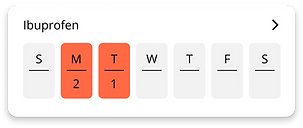
Taken three times a day
Taken once every other day
Taken as needed

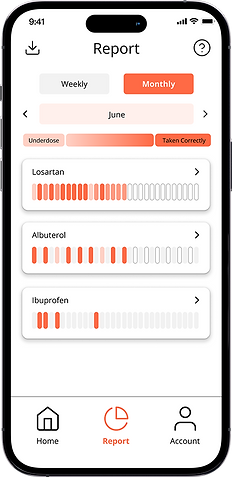
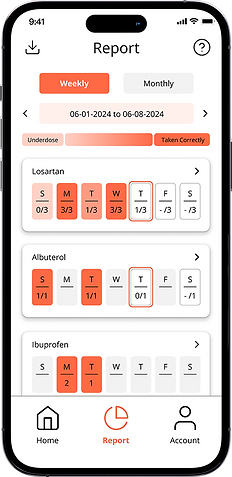
Patterns
Adherence
Calendar
Calendar View for Behavior Patterns
A detailed calendar view displays specific medication data over time, allowing users to visualize their behavior patterns. This helps users find ways to improve their adherence to medication routines.


07
Our impact.
User Test and Interview
Early Feedback & Insights
Through initial user tests and interviews with older adults and caregivers, we confirmed the urgent need for a simple, intuitive way to manage multiple medications. Older adults emphasized how important it is to maintain their independence, while caregivers and doctors stressed the ongoing challenge of sharing accurate adherence information.

Visualization
Reminder

Simplicity
Participants responded positively to our solution. They valued the reminder system for reducing forgetfulness, the visual reports for improving communication with doctors, and the ease of use after setup, which supports independence. The addition of a physical device was also seen as an effective way to make adherence more reliable.
At the same time, feedback highlighted that caregivers may need to assist with the initial setup and that visualizations could be further developed to better support clinical use.